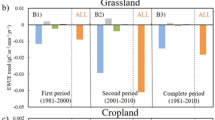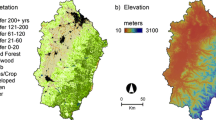Abstract
Climate warming due to the enhanced greenhouse effect is expected to have a significant impact on the natural environment and human activity in high latitudes. Because of its geography, wide coastal areas, water resources, forests, and wetlands, the environment of Estonia is sensitive to climate change and sea level rise. Climate change scenarios for Estonia were generated using a Model for the Assessment of Greenhouse-gas Induced Climate Change (MAGICC) and a regional climate change database, Scenario Generator (SCENGEN). Three alternative emission scenarios were combined with data from 14 general circulation model experiments. The assessment results of forest resources using RipFor, a forest-soil-atmosphere model, show that climate warming would enhance forest growth in Estonia resulting in increased productivity (2–9%) of harvestable timber on highly productive sites. Nutrient mobility increases greatly and in highly permeable soils with stable vegetation, increased mobility may result in nutrient losses through leaching. The assessment results of water resources using the simple water balance model, WatBal, show that the runoff regime of Estonian rivers would equilibrate and the groundwater table would rise. Climate warming would not cause any particular problems with water supply but the groundwater quality may suffer from increased leaching. Due to milder winters and increased storminess, the destruction of coastal areas, inundation of wetlands and disappearance of rare plant communities in coastal areas would be the most damaging results of climate change. Most sandy beaches high in recreational value would disappear. However, isostatic uplift and settlements inland from the present coastline reduce the risk of socio-economic decline.
Similar content being viewed by others
References
Arp P.A. and Oja T., 1997: A forest soil vegetation atmosphere model (ForSVA), I: concepts.Ecological Modelling 95: 211–224.
Arp P.A. and Yin X., 1992: Predicting water fluxes through forests from monthly precipitation and mean monthly air temperature records.Canadian Journal of Forest Research 22: 864–877.
Bruun P., 1962: Sea level rise as a cause of shore erosion.Journal of Waterway, Port, Coastal and Ocean Engineering, ASCE 88: 117–130.
Hands E.B., 1983: The Great Lakes as a test model for profile responses to sea level changes. In: Komar P.D. (ed.),Handbook of Coastal Processes and Erosionpp. 167–189. CRC Press, Boca Raton, Florida.
Houghton J.T., Meira Filho L.G., Callander B.A., Harris N., Kattenberg A. and Maskell K. (eds), 1996:Climate Change 1995: The Science of Climate Change. Contribution of Working Group I to the Second Assessment Report of the Intergovernmental Panel on Climate Change. Cambridge University Press, Cambridge.
Hulme M., Raper S.C.B. and Wigley T.M.L., 1995: An integrated framework to address climate change (ESCAPE) and further developments of the global and regional climate modules (MAGICC).Energy Policy 23: 347–356.
Ingelög T., Andersson R and Tjernberg M. (eds), 1993: Red Data Book of the Baltic Region, I: List of threatened vascular plants and vertebrates, 95 pp. Uppsala, Riga.
Järvet A., 1998: Assessment of the climate change impact on groundwater regime. In: Kallaste T. and Kuldna P. (eds),Climate change studies in Estonia, pp. 111–116. Tallinn.
Järvet A. and Vallner L., 1998: Assessment of the climate change impact on groundwater. In: Lemmelä R. and Helenius N. (eds),The Second International Conference on Climate and Water, pp. 1536–1544, Espoo, Finland, 17-20 August, 1998.
Järvet A., Jaagus J., Roosaare J., Tamm T. and Vallner L., 2000: Impact of Climate Change onWater Balance Elements in Estonia. In: Kaare T. and Punning J.-M. (eds),Estonia, Geographical Studies, Vol. 8, pp. 35–55. Estonian Academy Publishers, Tallinn.
Keevallik S., 1998: Climate change scenarios for Estonia. In: Country Case Study on Climate Change, Impacts and Adaptation Assessments in the Republic of Estonia, UNEP/GEF Project GF/pp2200-96-45 Report, pp. 30–35. Tallinn.
Kont A., Punning J.-M., Jaagus J., Klõšeiko J., Koff T., Mandre M., Roostalu H. and Tamm T., 1996a: Vulnerability and Adaptation Assessment for Estonia. In: Smith J.B.et al.(eds),Vulnerability and Adaptation to Climate Change. pp. 249–275. Kluwer Academic Publishers.
Kont A., Ratas U., Puurmann E., Ainsaar M., Pärtel M. and Zobel M., 1996b: Eustatic fluctuations of the World Ocean and their impact on the environment and social life of Estonia. In: Punning J.-M. (ed.),Estonia in the System of Global Climate Change. pp. 104–122. Publication of Institute of Ecology, Tallinn.
Kont A., Ratas U. and Puurmann E., 1997: Sea-Level Rise Impact on Coastal Areas of Estonia.Climatic Change 36: 175–184.
Legget J., Pepper W.J. and Swart R.J., 1992: Emission scenarios for the IPCC: An update. In: Houghton J.T., Callander B.A. and Varney S.K. (eds),Climate change 1992: the supplementary report to the IPCC scientific assessment. pp. 75–95. Cambridge University Press, Cambridge.
Mander ü., Oja T. and Lõhmus K., 1999: Nutrient transformation in riparian buffer zones: Modelling approach. In: Ecosystems and Sustainable Development II. Advances in Ecological Sciences, Vol. 2, pp. 3–13. WIT Press, Southampton, Boston, U.S.A.
Nilson A., Kiviste A., Korjus H., Mihkelson S., Etverk I. and Oja T., 1999: Impact of recent and future climate change on Estonian forestry and adaptation tools.Climate Research 12: 205–214.
Oja T. and Arp P.A., 1996: Nutrient cycling and biomass growth at a North American hardwood site in relation to climate change: ForSVA assessments.Climatic Change 34: 239–251.
Oja T. and Arp P.A., 1997: A Forest Soil Vegetation Atmosphere Model (ForSVA), II: Application to Northern Tolerant Hardwoods.Ecological Modelling 95: 225–247.
Orviku K., 1987: Estonian seashore and evolution tendencies.Eesti Loodus (Estonian Nature) 11: 712–719 (in Estonian with English summary).
Orviku K., 1992: Characterization and evolution of Estonian seashores.Summary of doctoral thesis at Tartu University, Tartu, Estonia.
Orviku K., 1993: The present state of Estonian coasts and evolution tendencies.In: Proceedings of the International Coastal Congress ICC-Kiel'92, pp. 621–624. Kiel, Germany.
Orviku K., 1995: Extensive Storm Damage on the Estonian Seashore-Sharpening Conflict between Man and Nature? In: Proceedings of the EUCC-WWF Conference, pp. 19–22, Klaipeda 3-7 May 1994.
Raukas A., Bird E.D. and Orviku K., 1994: The provenance of beaches on the Estonian islands of Hiiumaa and Saaremaa.Proceedings of the Estonian Academy of Sciences: Ecology 43(2): 81–92.
Rotmans J., Hulme M. and Downing T.E., 1994: Climate change implications for Europe: An application of the ESCAPE model.Global Environmental Change 4: 97–124.
Smith J.B. and Hulme M., 1998: Climate change scenarios, Chapter 3.In: Feenstra J.F., Burton I., Smith J.B. and Tol R.S.J. (eds),Handbook on Methods for Climate Change Impact Assessment and Adaptation Strategies. 37 pp., UNEP/Institute of Environmental Studies.
Statistical Yearbook, 2000: Statistical Office of Estonia, Tallinn. 445 pp.
Tarand A. and Kallaste T. (eds), 1998: Country Case Study on Climate Change, Impacts and Adaptation Assessments in the Republic of Estonia, UNEP/GEF Project GF/pp2200-96-45 Report, Tallinn, Estonia.
Vallner L., Sildvee H. and Torim, A. 1988: Recent crustal movements in Estonia.Journal of Geodynamics 9: 215–223.
Wigley T.M.L. and Raper S.C.B., 1992: Implications of revised IPCC emission scenarios.Nature 357: 293–300.
Yates D. and Strzepek K., 1994: Comparison of models for climate change assessment of river basin runoff. IIASA Working Paper 45, 48 pp.
Author information
Authors and Affiliations
Rights and permissions
About this article
Cite this article
Kont, A., Jaagus, J., Oja, T. et al. Biophysical impacts of climate change on some terrestrial ecosystems in Estonia. GeoJournal 57, 169–181 (2002). https://doi.org/10.1023/B:GEJO.0000003614.07684.60
Issue Date:
DOI: https://doi.org/10.1023/B:GEJO.0000003614.07684.60




